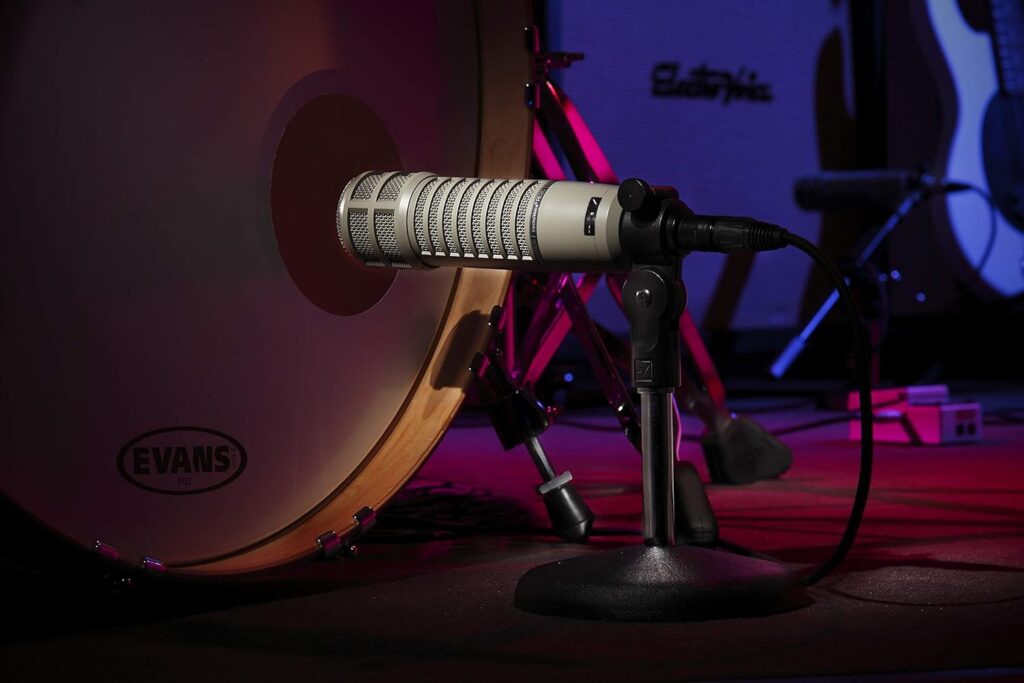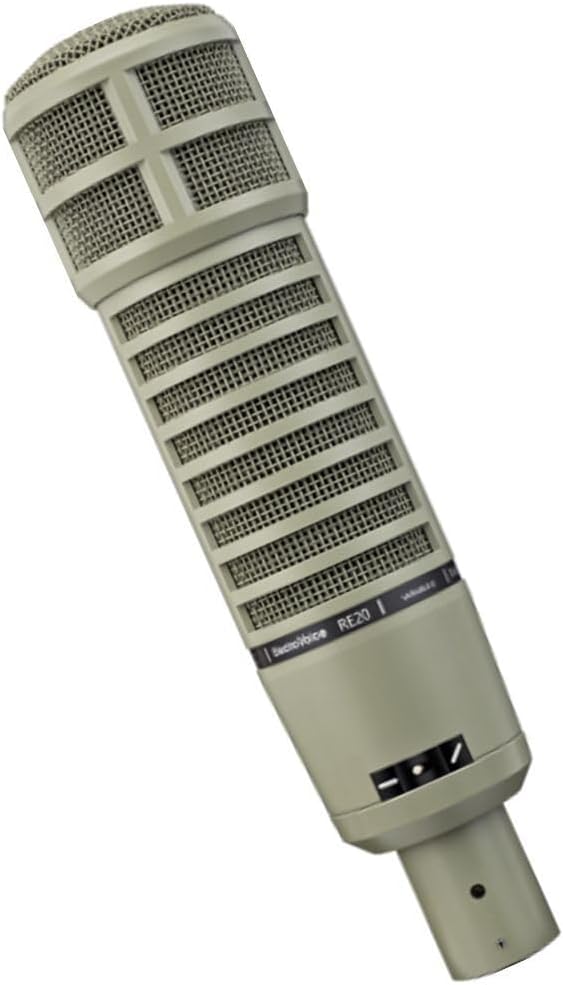Electro-Voice RE20 Review
The Electro-Voice RE20 is a microphone that needs no introduction in the world of professional audio. For over half a century, this dynamic cardioid microphone has been a staple in recording studios, broadcast booths, and live sound environments. Known for its robust build, exceptional sound quality, and versatility, the RE20 has earned a reputation as one of the most reliable tools in the audio engineer’s arsenal. In this comprehensive review, we’ll dive into what makes the RE20 so special, exploring its design, performance, practical applications, and how it stacks up against modern competitors. Whether you’re a podcaster, musician, or broadcaster, this review will help you decide if the RE20 deserves a spot in your setup.
Electro-Voice RE20 Review
First introduced in 1968 by Electro-Voice, a Michigan-based audio company with a long history of innovation, the RE20 was designed to meet the demands of broadcasters who needed a microphone that could deliver pristine sound in challenging environments. Its unique Variable-D technology—a patented feature that minimizes the proximity effect—set it apart from the competition. Over the decades, it became a favorite not just for radio and television but also for music recording and live sound reinforcement. From capturing the smooth tones of a radio DJ to taming the thunderous kick of a drum, the RE20 has proven its staying power.
Today, in 2025, the RE20 remains largely unchanged from its original design, a testament to its enduring quality. While Electro-Voice has introduced newer models and competitors have flooded the market with high-tech alternatives, the RE20 continues to hold its own. Let’s break down why.
Design and Build Quality
The RE20 is a microphone you notice the moment you pick it up. Weighing in at 1 pound, 10 ounces (737 grams), it’s hefty but not unwieldy. Its all-metal construction exudes durability, with a steel body finished in a sleek, satin nickel or fawn beige coating (depending on the variant). The microphone measures 8.53 inches (217 mm) in length and 2.13 inches (54 mm) in diameter at its widest point, giving it a substantial yet ergonomic feel.
The front grille is understated but functional, designed to protect the dynamic capsule while allowing sound to pass through cleanly. A standout feature is the integrated pop filter—a dual-layer windscreen that reduces plosives (those harsh “p” and “b” sounds) without the need for an external accessory. This makes it especially appealing for vocalists and broadcasters who want a clean signal straight out of the box.
On the side, you’ll find two switches: a bass roll-off toggle and a high-pass filter. These give users some control over the microphone’s frequency response, allowing for quick adjustments depending on the sound source. The XLR connector at the base is standard and secure, ensuring a reliable connection to preamps or mixers.
One minor critique of the design is its lack of a built-in shock mount. Given its weight and typical use cases (like mounting on a stand for broadcast or recording), it’s prone to picking up vibrations if not paired with a separate shock mount. Electro-Voice does sell a compatible 309A suspension mount, but it’s an additional expense that some users might find inconvenient.
Sound Quality: The Heart of the RE20
The RE20 is a dynamic microphone with a cardioid polar pattern, meaning it picks up sound primarily from the front while rejecting noise from the sides and rear. Its frequency response spans 45 Hz to 18 kHz, offering a wide range that captures both deep lows and crisp highs. But what truly defines the RE20’s sound is its Variable-D technology.
The proximity effect—where bass frequencies get boosted when a sound source is close to a microphone—can be a challenge with many cardioid mics. The RE20’s Variable-D design uses multiple ports along the microphone’s body to balance the sound, ensuring a consistent tonal quality regardless of how close or far the source is. This makes it a dream for broadcasters who might shift positions during a session or vocalists who vary their distance for effect.
Out of the box, the RE20 delivers a warm, natural sound with a slight presence boost around 3-5 kHz. This gives voices a touch of clarity and articulation without sounding harsh or overly bright. The low end is full but controlled, making it ideal for capturing the richness of a baritone voice or the punch of a bass drum. The high-pass filter (when engaged) rolls off frequencies below 100 Hz, which is handy for reducing rumble or handling noise in less-than-ideal recording spaces.
Off-axis rejection is another strength. The RE20 excels at minimizing bleed from nearby instruments or ambient noise, a critical feature for live settings or multi-mic studio sessions. Its dynamic capsule also means it can handle high sound pressure levels (SPL) without distortion—up to 150 dB, according to Electro-Voice—making it a go-to choice for loud sources like guitar amps or brass instruments.
Performance in Real-World Applications
So, how does the RE20 perform in practice? Let’s explore its most common use cases.
Broadcasting and Podcasting
The RE20 is often called the “broadcast standard,” and for good reason. Its ability to produce a polished, radio-ready voice with minimal EQ or processing is unmatched among dynamic mics. The Variable-D technology ensures that even inexperienced speakers who move around won’t sound boomy or thin. The built-in pop filter handles plosives effortlessly, though a foam windscreen can be added for extra protection in windy outdoor settings.
Podcasters love the RE20 for its plug-and-play simplicity. Pair it with a decent preamp (it requires a bit of gain, around 60 dB, due to its low output), and you’re ready to record professional-grade audio. Its off-axis rejection also makes it forgiving in untreated rooms, where reflections and background noise might otherwise intrude.
Music Recording
In the studio, the RE20 shines on a variety of sources. It’s a favorite for kick drums, where its tight low-end response and ability to handle high SPL deliver a powerful yet defined sound. Position it just inside the drum’s port hole, and you’ll get a mix of thump and attack that sits well in a mix with minimal EQ.
For vocals, the RE20 offers a smooth, warm character that flatters most voices. It’s less detailed than a high-end condenser mic, but that’s part of its charm—it softens imperfections and adds a vintage vibe. Guitar amps, horns, and even upright bass benefit from its balanced response and proximity-effect control.
Live Sound
While less common in live settings due to its size and weight, the RE20 can hold its own on stage. Its rugged build withstands the rigors of touring, and its directional pickup pattern reduces feedback in monitor-heavy environments. Sound engineers often use it for drum miking or as a handheld vocal mic for performers who want a broadcast-like tone.
Comparisons to Other Microphones
How does the RE20 stack up against its peers? Let’s compare it to a few notable alternatives.
Shure SM7B
The Shure SM7B is the RE20’s closest rival in the broadcast and studio world. Both are dynamic cardioid mics with a focus on vocal clarity, but they differ in flavor. The SM7B has a slightly darker, more mid-forward sound with a pronounced presence peak, while the RE20 is flatter and more natural. The SM7B’s bass roll-off is more aggressive, which can be a pro or con depending on the application. Price-wise, they’re in the same ballpark (around $400 USD), though the RE20 feels more premium in hand.
Sennheiser MD 421-II
Another dynamic mic popular for instruments, the Sennheiser MD 421-II offers a tighter cardioid pattern and a brighter top end. It’s excellent for toms and guitar cabs but lacks the RE20’s proximity-effect control, making it less ideal for vocals. The MD 421-II is also lighter and more compact, which might appeal to live sound engineers.
Neumann U87
A condenser mic like the Neumann U87 is in a different league, offering greater detail and sensitivity for studio recording. However, it’s far more fragile, requires phantom power, and costs over $3,000—making the RE20 a practical, budget-friendly alternative for many users.
Pros and Cons
Pros:
- Exceptional sound quality with a warm, natural tone
- Variable-D technology eliminates proximity effect
- Built-in pop filter reduces plosives
- Durable, all-metal construction
- Versatile for vocals, instruments, and broadcast
- Excellent off-axis rejection
Cons:
- Heavy and bulky for handheld use
- No included shock mount
- Requires significant gain (60 dB or more)
- Premium price for a dynamic mic
Who Should Buy the RE20?
The Electro-Voice RE20 is a microphone for professionals and serious hobbyists who value reliability and versatility. If you’re a podcaster aiming for a polished, broadcast-quality sound, a musician recording drums or vocals, or a broadcaster needing a workhorse mic, the RE20 is a worthy investment. It’s less suited for casual users on a tight budget or those who prioritize portability over performance.
At around $450 USD (as of 2025), it’s not cheap, but its longevity and timeless design justify the cost. Pair it with a quality preamp like the Cloudlifter or a Focusrite interface, and you’ll unlock its full potential.
Final Thoughts
The Electro-Voice RE20 isn’t just a microphone—it’s a legacy. Its blend of innovative engineering, rugged durability, and superb sound quality has kept it relevant for over 50 years. While it’s not perfect (the lack of a shock mount and high gain requirement are minor gripes), its strengths far outweigh its flaws. Whether you’re capturing the next hit song or hosting a podcast that reaches millions, the RE20 delivers consistency and character that few mics can match.
In a world of flashy new gear, the RE20 stands as a reminder that sometimes the classics are classic for a reason. If you’re ready to elevate your audio game, this microphone deserves a spot on your shortlist.



